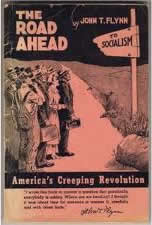Between 1942 and 1945 the National Association of Manufacturers (NAM) facilitated the formation of various Committees on Cooperation with Education. By the late 1940s the work of these Committees in coordinating business and teacher exchanges was carried on at the national level by organizations such as the National Education Association, the American Council on Education, the American Vocational Association and others. The US Chamber of Commerce also established over 1300 Committees on Education between 1944 and 1949 that sought to bring together teachers and business people and others.
Fred G. Clark founded the American Economic Foundation (AEF) in 1939. Before founding AEF, Clark was involved in broadcasting anti-socialist radio programs for the Crusaders, which he headed. The AEF was financially supported by a number of industry and conservative interests, including the founders of Readers Digest and NAM. Many utilities also contributed to it. From 1943 onwards, the AEF was heavily involved in providing economic training to millions of workers and thousands of teachers, as well as community groups. It produced films that were used by 7000 high schools in 41 states, as well as distributing editorials, promoting ideologically correct textbooks and organising a speakers’ bureau. It compiled the ‘Ten Pillars of Economic Wisdom’, which were promoted by other right-wing organizations, including the John Birch Society when it was founded. These Pillars included:
The same corporations funded the Foundation for Economic Education (FEE), the American Enterprise Association, the National Economic Council and the Committee for Constitutional Government. The Committee for Constitutional Government stated in its prospectus that its major purpose was to ‘indoctrinate 10,000 college students’ with ‘facts’ about ‘their heritage of economic and constitutional freedom’ and thus ‘fortify our form of government against socialistic trends’. Whilst FEE had been able to avoid registering under the Lobby Act by falsely claiming that its purpose was not to ‘carry on propaganda or otherwise influence legislation’, the Committee for Constitutional Government was unable to avoid it and in 1949 it was recorded as spending second highest of all lobbies in the country.
 The Committee also played a large part in popularizing the book, The Road Ahead by John T Flynn, that was published in 1949. Flynn wrote pamphlets for the National Economic Council and was on the executive of the American Action. He was associated with the Committee for Constitutional Government and its offshoot, Fighters for Freedom.
The Committee also played a large part in popularizing the book, The Road Ahead by John T Flynn, that was published in 1949. Flynn wrote pamphlets for the National Economic Council and was on the executive of the American Action. He was associated with the Committee for Constitutional Government and its offshoot, Fighters for Freedom.
The Road Ahead, which was described in the New York Times Book Review as an extreme manifestation of ‘an endemic hysteria presently affecting a considerable segment of our society’, argued that socialism was the major threat facing America and ‘our whole way of life’. This socialism was of the type emerging in England with the rise of the Labor Party and associated with the Welfare State. Its advocates did not label themselves as socialists but nevertheless they had the same goals. Flynn, noting that Truman looked like following these same goals, claimed: ‘We cannot depend on any political party to save us. We must build a power outside the parties so strong that the parties will be compelled to yield to its demands.’
The book first went on sale at $2.50 a copy and sold about 60,000 copies. It was then taken up by the Committee for Constitutional Government which cut the price dramatically and sold 600,000 copies over the next five months. It sent out about 3.5 million postcard advertisements for the book and sold many in bulk lots to corporations and lobbying groups interesting in promoting the book’s message. It subsidized individuals and groups to finance its free distribution to key individuals such as clergymen and educators, businessmen, editors, judges, public officials and farm leaders.
Readers Digest printed a condensed version of the book in 1950 which was distributed to 9 million people and it was also reprinted in condensed version in the Congressional Record as well as various newspapers. The American Medical Association, which was fighting against a national health program, also found it opportune to invest in the book and distribute free copies. Doctors and dentists surgeries had piles of free copies for waiting patients. Congressmen posted them out for free. In the end some twelve million or more were distributed.